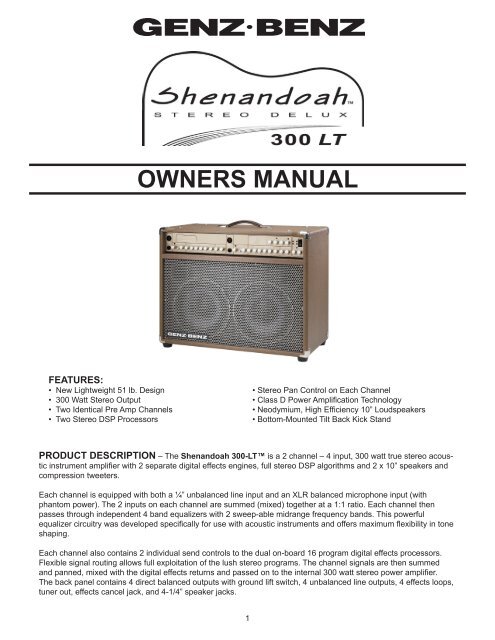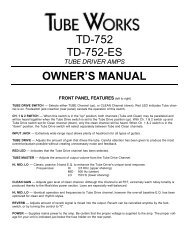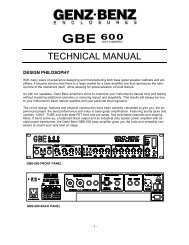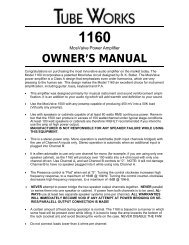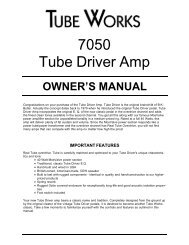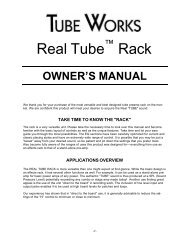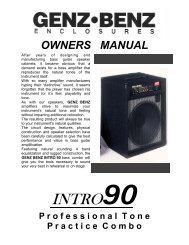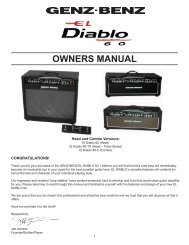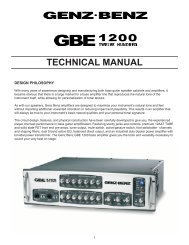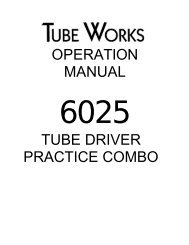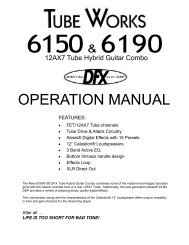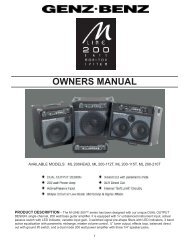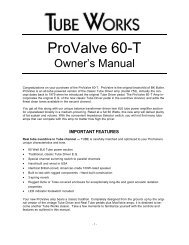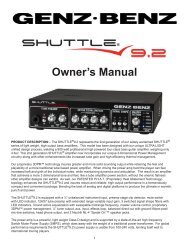Shenandoah 300 LT Manual - Genz Benz
Shenandoah 300 LT Manual - Genz Benz
Shenandoah 300 LT Manual - Genz Benz
Create successful ePaper yourself
Turn your PDF publications into a flip-book with our unique Google optimized e-Paper software.
OWNERS MANUALFEATURES:• New Lightweight 51 lb. Design• <strong>300</strong> Watt Stereo Output• Two Identical Pre Amp Channels• Two Stereo DSP Processors• Stereo Pan Control on Each Channel• Class D Power Amplification Technology• Neodymium, High Efficiency 10” Loudspeakers• Bottom-Mounted Tilt Back Kick StandPRODUCT DESCRIPTION – The <strong>Shenandoah</strong> <strong>300</strong>-<strong>LT</strong> is a 2 channel – 4 input, <strong>300</strong> watt true stereo acousticinstrument amplifier with 2 separate digital effects engines, full stereo DSP algorithms and 2 x 10” speakers andcompression tweeters.Each channel is equipped with both a ¼” unbalanced line input and an XLR balanced microphone input (withphantom power). The 2 inputs on each channel are summed (mixed) together at a 1:1 ratio. Each channel thenpasses through independent 4 band equalizers with 2 sweep-able midrange frequency bands. This powerfulequalizer circuitry was developed specifically for use with acoustic instruments and offers maximum flexibility in toneshaping.Each channel also contains 2 individual send controls to the dual on-board 16 program digital effects processors.Flexible signal routing allows full exploitation of the lush stereo programs. The channel signals are then summedand panned, mixed with the digital effects returns and passed on to the internal <strong>300</strong> watt stereo power amplifier.The back panel contains 4 direct balanced outputs with ground lift switch, 4 unbalanced line outputs, 4 effects loops,tuner out, effects cancel jack, and 4-1/4” speaker jacks.
INPUTS - The <strong>Shenandoah</strong> <strong>300</strong>-<strong>LT</strong> is equipped with two types of input jacks. The ¼” input is unbalanced and“line/instrument level” with a usable sensitivity from 80 mV to 1.6 volt. The input impedance is 220k ohms. The ¼” inputwill also accept most active balanced line sources, automatically unbalancing them by recognizing the tip portion ofthe balanced signal. If an instrument offers an unbalanced output it should be connected to the unbalanced input ofthe <strong>Shenandoah</strong> amp. Additionally, the precision input scaling preamp contains a 45 Hz, 12 dB/octave high pass filter(more effective and less intrusive than the more common 6 dB filters) and an “RFI” filter (radio frequency interference)to eliminate unwanted noise. The XLR input jack is balanced and “microphone level”, with a usable sensitivity from-60dBv to -30 dBv. It is not a line level input. It contains a precision full range differential microphone preamp withphantom power. For use with higher-level sources (such as the balanced line level output from a keyboard or otherinstruments), a balanced pad network will be necessary to use the balanced input. For instance, a Rapco “Pad Blox”,-20 or -30 pad or similar product could be used.PHANTOM POWER - An internal phantom power source (13.6 volts) is provided for use with condenser mics. Thispower source is on at all times and does not affect the standard operation of the amp, even when a condenser mic isnot used. We use the DIN 45-596-P12 volt standard, which will operate virtually all of the live sound reinforcement condensermicrophones on the market. Some “boutique” externally biased condenser mics will not be compatible and willrequire 48 volt phantom power. We suggest live sound condenser mics: AKG, Audio Technica, CAD, Shure and Crown.PREAMP GAIN CONTROL – This level control sets the amount of gain at the input of the preamp. Use thiscontrol to set the input level in conjunction with the CLIP LED indicator.INPUT O/L LED – The red CLIP LED senses the input signal to the preamp section and warns of input overload.For the cleanest signal possible this LED should only flash with the strongest signal peaks. Adjust this sensitivity withthe input gain control.PHASE SWITCH – Each input is provided with a phase reverse switch. By reversing the phase of the inputsignal, feedback tendencies can be reduced if caused by sympathetic vibrations between the speaker and theinstrument. Under some conditions, changing the phase can drastically improve the output from the amplifier and canimprove the playability of some instruments.PAN CONTROL – Each input channel is provided with a pan control, which adjusts the balance of the input signalbetween the left and right output amplifiers. This control does not affect the assignment of the effects send signals.COMBINING XLR & ¼” INPUTS – A unique feature of the <strong>Shenandoah</strong> <strong>300</strong>-<strong>LT</strong> is the ability to mix the XLRbalanced and ¼” unbalanced inputs on each channel. In many situations, this effectively makes the amplifier functionas a 4 channel amplifier. The most effective way to use this feature is to set the volume on the channel using the XLRmicrophone input and then adjust the level control on the instrument itself (assuming that it has one) to blend levelsbetween the 2 inputs. Equalization will be common to both inputs on the channel.
ON-BOARD STEREO DIGITAL EFFECTS – The <strong>Shenandoah</strong> <strong>300</strong>-<strong>LT</strong> contains 2 genuine studio quality16 program stereo digital effects processors. We chose industry standard digital signal processing for realistic, highquality stereo effects algorithms. Not all effects will be suitable for all types of instruments or playing styles, buteveryone should find a good selection of solid, useable programs. Just keep in mind that a program that doesn’twork well for your acoustic guitar or mandolin work (long lush reverbs for example) may be the perfectprogram for jazz guitar, sax or flute. Effects volume differences are normal when switching between different effectsprograms. Adjust the effects send and master levels accordingly.One of the most powerful features of the DSP engine is its ability to process a large amount of audio data in realtime.This allows us to take advantage of several important concepts in generating a believable stereo image. Bydelaying a portion of the signal by an “early reflection ratio”, applying DSP processing in stereo to this signal, thensumming it back with the original signal and returning the mix to the program bus, the resulting stereo image is big,lush and exceptionally stable.The “Effects Send A” control on each channel adjusts the send level to digital effects processor “A” and the “EffectsSend B” control on each channel adjusts the send level to digital effects processor “B”. The “Digital Effects Level”control in the master section adjusts the effects return level from the corresponding processor. The effects returnsignals are summed and routed directly to the left and right amplifiers.A ¼” TRS effects cancel jack is provided on the back panel to mute the internal effects via footswitch included. Anystandard 2 button latching footswitch may be used. Ring controls Effects Return A and Tip controls Effects Return B.The effects signal is muted when the switch is open. LED’s show when the effects are active.PROGRAM DESCRIPTIONSNAMEHall 1Hall 2Room 1Room 2Room 3Plate 1Plate 2Plate 3ChorusFlangeDelay 1Delay 2Chorus/PlateChorus/RoomSonic EnhancePitch Shift RotaryDESCRIPTIONBright hall reverbWarm hall reverbHardwood studio reverbAmbient room reverbWarm room reverb for guitars and rhythm instrumentsClassic plate reverb for lead vocals and instrumentsSizzling bright plate reverb for vocalsShort “vintage” plate reverbChorus (Tonal variations in pitch and volume)Flanger for jet wash effects125ms slapjack delay190ms slapjack delayChorus with reverb plateAuto-wah guitar effect with reverbMid-Range scoop toneRotary speaker emulationACTIVE 4 BAND EQUALIZATION – Each channel of the <strong>Shenandoah</strong> <strong>300</strong>-<strong>LT</strong> contains a separate 4 band(with 2 sweepable mids) active equalizer. These equalizers, similar to those found on professional sound consoles, arevery useful tools when used correctly.LOW FREQUENCY EQ - The corner frequency of the low frequency section is 125 Hz, with a shelving curve type.This frequency is particularly handy when dealing with low frequency feedback from a big dreadnaught guitar, cello, orupright bass. With a “boomy” instrument on a small stage, a combination of volume reduction and turning down the lowfrequency control will generally get good results. The low frequency control is also handy for adding some “bottom” to abaritone sax and “chunk” to many stringed instruments.
HIGH FREQUENCY EQ - The corner frequency of the high frequency section is 8 kHz, shelving curve type.This frequency is especially useful for taming the bright harshness of some mandolins, violins, brass, and reeds.It can also be used to help acoustic guitars, cellos, and flutes cut through other players in loud club situations, orwhere drums are present.MIDRANGE EQ - The “sweep mid” section features 2 independent midrange equalizers, peaking curve type, withover 15dB of cut or boost and a bandwidth approximately 1 octave wide. The center frequencies of these equalizationfilters are continuously user adjustable from 100 Hz to 1.8kHz (LOW MID) and 350 Hz to 5 kHz (HIGH MID) withthe corresponding frequency control. These filters are typically (but not always) used to reduce or remove offendingfrequencies in the instrument’s pick-up response. Removing only the minimum amount necessary will yield the mostacoustically rewarding results. The easiest and most repeatable way to determine the offending frequency rangeis to boost the mid level somewhat (but not to the point of feedback) and then while playing, sweep the frequencycontrol slowly across its range. You may need a third hand until it becomes second nature, but soon you will find outjust how quick it can be. You will hear a clear and obvious accentuation of the “ugliness” you wish to remove. Then,reduce the gain control until the sound you desire is attained. The ear is a most sensitive and discriminating piece oftest equipment when used in this manner, another good reason to protect them! This is the way many touring soundengineers equalize, since it is quick, accurate and repeatable. Occasionally, you will find need to use the mid sectionin “boost” mode, particularly common when adding higher midrange (bite) to an otherwise dull instrument, or addinglow mid “body” to an otherwise thin sound. Spend some time experimenting so that the process becomes creative aswell as corrective.AUXILIARY INPUT LEVEL CONTROL – The <strong>Shenandoah</strong> <strong>300</strong>-<strong>LT</strong> is equipped with both ¼” and dual RCAaux. input jacks and an aux level control. These rear panel jacks are internally summed and feed the stereo mix viathe aux. level control. Both aux. inputs are line level for use with drum machines, CD, iPod, MP3 and tape players.MASTER VOLUME – The stereo master volume control adjusts the overall volume of the mix of channel 1,channel 2, effects return 1 and effects return 2. Typically, best results are obtained when this control is operatedbetween the 9:00 and 3:00 positions.MASTER STATUS LED INDICATORS - Output status LED’s are provided to indicate signal present andclipping. The green LED monitors the pre master volume output signal from the preamp before the power ampsection. The red LED indicates clip/limit and shows that the maximum power threshold has been crossed and theinternal “soft-clip” limiter is active. Driving the amp 6db beyond this point will cause gradual clipping.DIRECT OUTPUTS – The <strong>Shenandoah</strong> <strong>300</strong>-<strong>LT</strong> contains the most comprehensive direct output section availableon any acoustic instrument amplifier. The XLR balanced and ¼” unbalanced outputs make “real world sense” when connectingwith other equipment. The ¼” unbalanced outputs are true professional line level (+4 dbv) with an output impedanceof 1k ohm, and can drive virtually any line level input, including power amplifiers. The XLR balanced output is “hot”mic level, rated at –30 dBv. This configuration allows the <strong>Shenandoah</strong> <strong>300</strong>-<strong>LT</strong> to drive very long cable lengths (250+feet) without problems or added noise and is compatible with all commonly encountered mixing consoles. The XLR balanceddirect outputs can be “ground lifted” with the global ground lift switch. This switch lifts pin 1 on all of the XLR balancedoutputs to break any ground loops between the <strong>Shenandoah</strong> <strong>300</strong>-<strong>LT</strong> and a PA system (or recording) console.Direct outputs are provided for each channel. Channel 1 and Channel 2 outputs are post channel volume/pre effects(to take advantage of the dual inputs on each channel) while the left & right main outputs are post master volume/posteq/post effects to aid in sending a ‘finished’ mixed signal to a PA system or external power
CHANNEL INSERTS / EFFECTS LOOP – The <strong>Shenandoah</strong> <strong>300</strong>-<strong>LT</strong> is equipped with insert points oneach channel AND on the left and right main signal paths. These points are handy for inserting compressors anddedicated digital effects processors. Signal is line level and unbalanced.POWER AMPLIFIER – The <strong>Shenandoah</strong> <strong>300</strong>-<strong>LT</strong> uses a state of the art, class D power amplifier designand a high frequency switch-mode power supply (SMPS) to achieve unprecedented high performance and lightweightpackaging. The switch-mode power supply utilizes high frequency switching to reduce the size and weightof the magnetic and filter components while increasing the performance by recharging the power supply rails about120,000 times each second! The class D amplifier uses digital PWM (pulse width modulation) techniques similarto those in more familiar digital to analog converters to reduce the size and weight by a factor of 10 times that of acomparably rated conventional class AB amplifier. Additionally, we developed our own, proprietary limiting and signalprocessing techniques to give a distinctly analog feel and sound to the class D platform.TUNER OUT – This jack is provided for use with all tuners that accept a ¼” input. The signal from this jack is postchannel volumes and works well with all known tuners.EFFECTS JACK – This jack is provided for use with the 2 button DSP footswitch which comes standard with the<strong>Shenandoah</strong> <strong>300</strong>-<strong>LT</strong>. This footswitch turns both DSP A and B programs ON and OFF. This is a useful tool for preselectingprograms and then turning them on or off when desired.SPEAKER OUTPUT JACKS – The <strong>Shenandoah</strong> <strong>300</strong>-<strong>LT</strong> provides 2 sets of parallel ¼” speaker output jacks.Minimum total load is 4 ohms (2 x 8 ohm loudspeakers) on each output channel. The combo is equipped with a 10”neodymium cast frame - 8 ohm loudspeaker and compression tweeter per side and may drive an additional 8 ohmextension speaker cabinet per side. We offer the Shen-<strong>300</strong> EXT L/R speaker enclosures that are a matched pair ofleft and right imaged extension speakers that offer the same compliment of 10” woofer and compression tweeterslike those in the <strong>Shenandoah</strong> <strong>300</strong>-<strong>LT</strong>.POWER INPUT – VO<strong>LT</strong>AGE SELECTOR SWITCH - The <strong>Shenandoah</strong> <strong>300</strong>-<strong>LT</strong> utilizes rear panel switchselectable universal power supply that operates from 100V to 240 volts, 50 to 60 Hz for world wide use. Simply setthe switch to the appropriate AC mains voltage (BEFORE connecting to the power source), and utilize the properIEC cord-set appropriate for the country the product is being used. For countries using 100V, 110V, 115V and 120VAC mains, select the 115V switch position on the Voltage Selector switch. For countries using 220V, 230V, and 240VAC mains, select the 230V switch position on the Voltage Selector switch. There is an AC mains (live) fuse locatedin a slide out tray at the bottom of the IEC power inlet socket. This is a slo-blo 5A fuse for all input voltages.TWEETER LEVEL CONTROLS – A tweeter level control is provided on each side of the speaker enclosurefor maximum tonal flexibility. The “rocker switch” control offers FULL tweeter output, - 6db level or a tweeter OFFposition. Experiment with different settings to find the best position for your personal taste.SPEAKER CABINET CONFIGURATION – This high-powered professional product is constructed from birchand sustainable plywood’s, resulting in an extremely lightweight enclosure with excellent projection and tone. A bottom-mounted,tilt-back stand is provided so that the speaker can be tilted up towards the performer. The loudspeakeris our custom designed GNX10250 cast-frame 10” neodymium magnet structure with a precision edge-wound voicecoil and Kapton bobbin, which is extremely efficient and lightweight compared to conventional speaker motor structures.A compression tweeter is utilized for the high frequency reproduction and delivers articulate, pristine, clarityand texture.
SHENANDOAH <strong>300</strong>-<strong>LT</strong>ENGINEERING SPECIFICATIONSINPUTSXLR Balanced channel input impedance:2.2k ohmsXLR Balanced channel input sensitivity:-60 to –30 dBV¼” Unbalanced channel input impedance: 220k ohms¼” Unbalanced channel input sensitivity: -22 to +4 dBV¼” Unbalanced aux input impedance: 10k ohms¼” Unbalanced aux input sensitivity: -10 to +4 dBVPhantom power (XLR Inputs)+13.6VAMPLIFIER OUTPUT (each channel)Power at 8 ohm load:Power at 4 ohm load:THD + N (preamp):THD + N (power amp):Frequency response:CHANNEL EQUALIZATIONLow frequency:Low-Mid frequency (sweep):High-Mid frequency (sweep):High frequency:100 watts RMS150 watts RMS
CAUTION!• Never set an amplifier on anything that will tip over or collapse under its weight.• These amplifiers are capable of producing sound pressure levels that may cause hearing loss.• There are no user serviceable parts inside these units. Always consult a qualified repair facility for service.WARNING!• The use and operation of this device constitutes an agreement of full release of any and all liabilityconnected with its use. Only persons familiar with the operation of high powered audio equipment shouldattempt to operate this device.• In addition, by use of this device, the user agrees to hold <strong>Genz</strong> <strong>Benz</strong> and its designers, sales agents and allother affiliates and related parties harmless in the event of any accident, injury, damage or loss resultingfrom such use.• Manufacturer’s sole responsibility is to provide a warranty on the specified performance of the product undernormal operating conditions for a period of 3 years.WARRANTY:• <strong>Genz</strong> <strong>Benz</strong> warrants the model <strong>Shenandoah</strong> <strong>300</strong>-<strong>LT</strong> to be free from defects inmaterials and workmanship for a period of 3 years from the date of purchase, when purchased from anauthorized <strong>Genz</strong> <strong>Benz</strong> dealer.• This warranty does not cover normal wear and tear incurred from the normally designed use of the product.• This warranty is effective only if a copy of the original sales receipt is presented at the time of warrantyservice.• This limited warranty is completely transferable to any subsequent buyer as long as the original salesreceipt is also transferred to such subsequent buyer.• All warranty service must be performed by a <strong>Genz</strong> <strong>Benz</strong> authorized service center.• Before returning any unit for service, a returned merchandise authorization number (RMA#) must beobtained by calling 480-941-0705.• This warranty is valid in the US and Canada only. For all products sold outside the USA, warranty is handledthrough our international distributor for each country.For more information, visit out website: www.genzbenz.com
Declaration of Conformity(89/336 EEC-EMC Directive)Manufacturer’s Name:Manufacturer’s Address:<strong>Genz</strong> <strong>Benz</strong>, a division of KMC Music Corporation7811 East Pierce StreetScottsdale, AZ 85257, U.S.A.Product Type:Audio AmplifierModel Number:<strong>Shenandoah</strong> <strong>300</strong>-<strong>LT</strong>Operating Power Condition: 100/115/230/240 V, 50/60 HzEffective Date: 06-01-2008Conforms to the Following Standards: [X] EN 55013: 2001 + A1: 2003[X] EN 55020: 2002 + A1: 2003[X] EN 60065: 2001 + A1[X] IEC 61000-3.3: 1994 + A1: 2001[X] IEC 61000-4.2[X] IEC 61000-4.3[X] IEC 61000-4.4[X] FCC 15.107 AND 15.109[X] RoHS Directive 2002/95/EC[X] WEEE Directive 2002/96/EC[X] CE Mark LV Directive 73/23 EECREV 27811 E. Pierce St. Scottsdale, AZ 85257PH: 480-941-0705 FAX: 480-946-2412www.genzbenz.comA KMC Music Corporation, Bloomfield, CT


